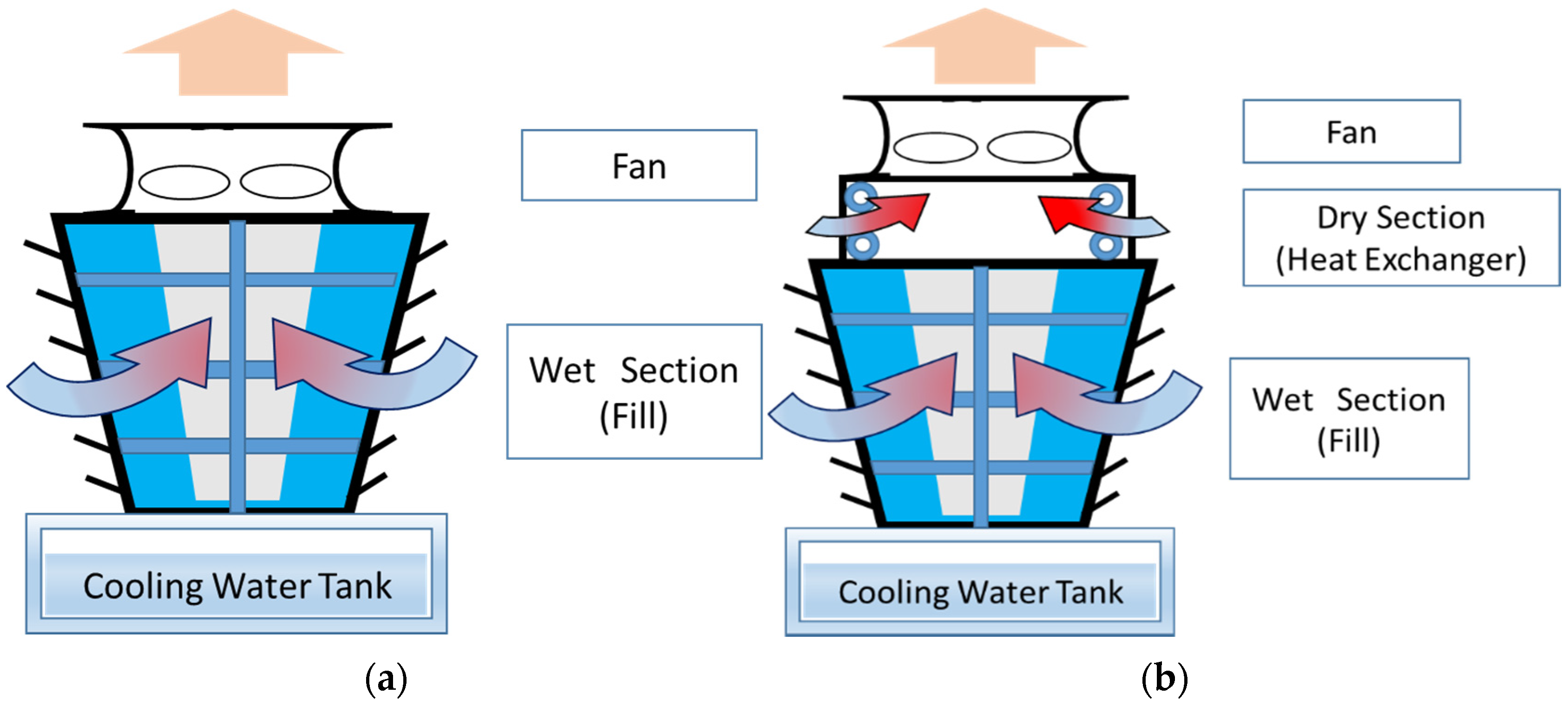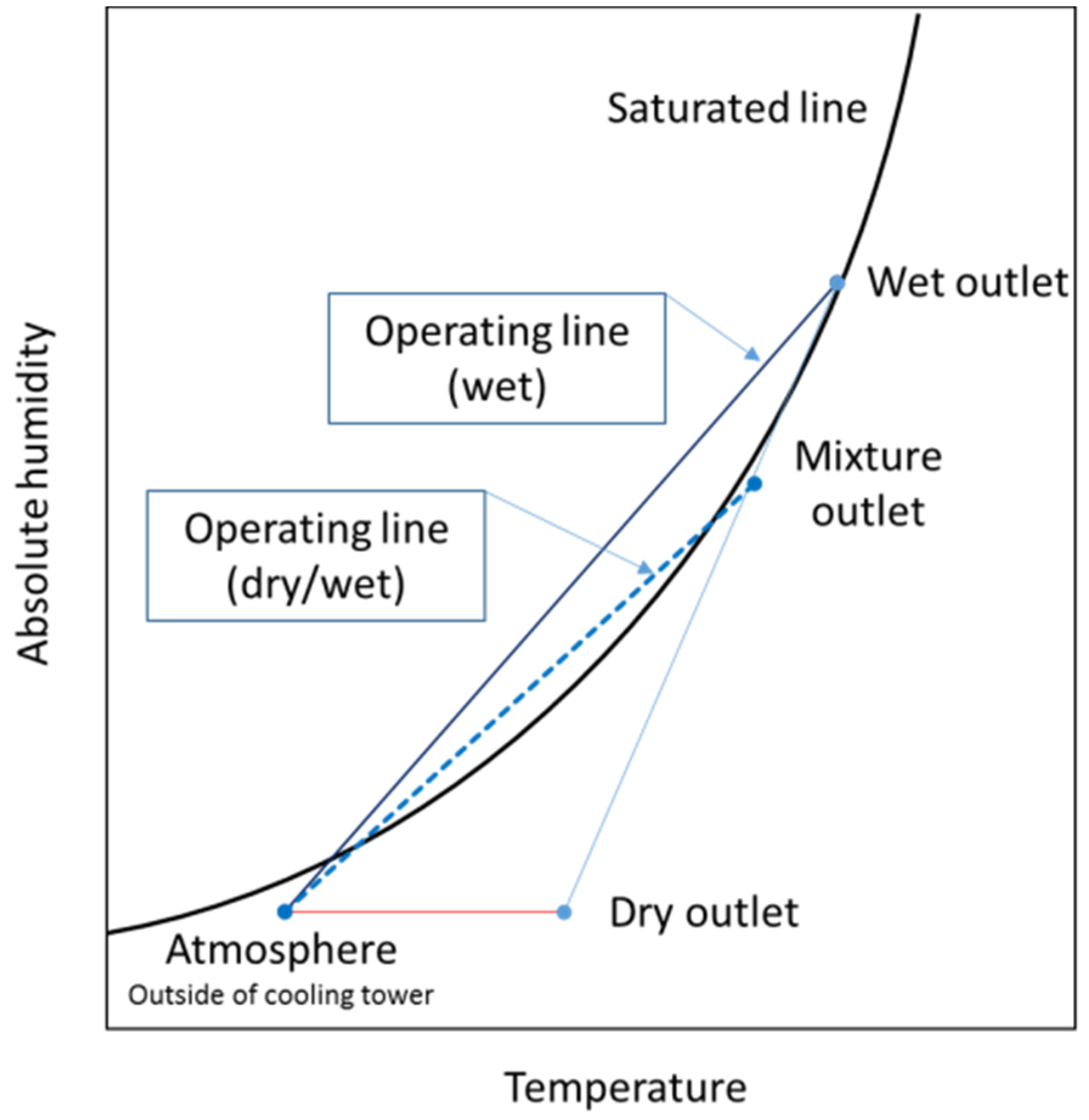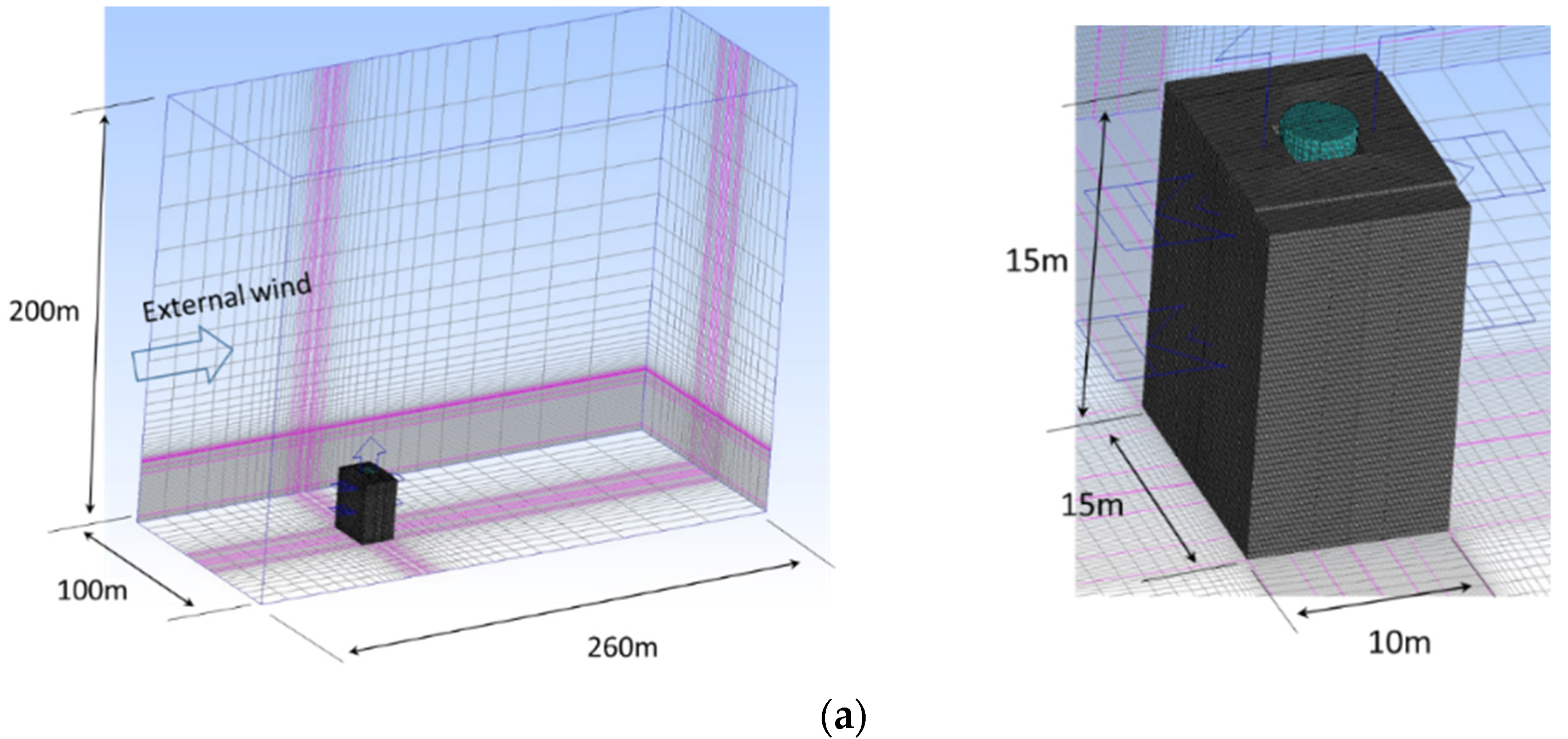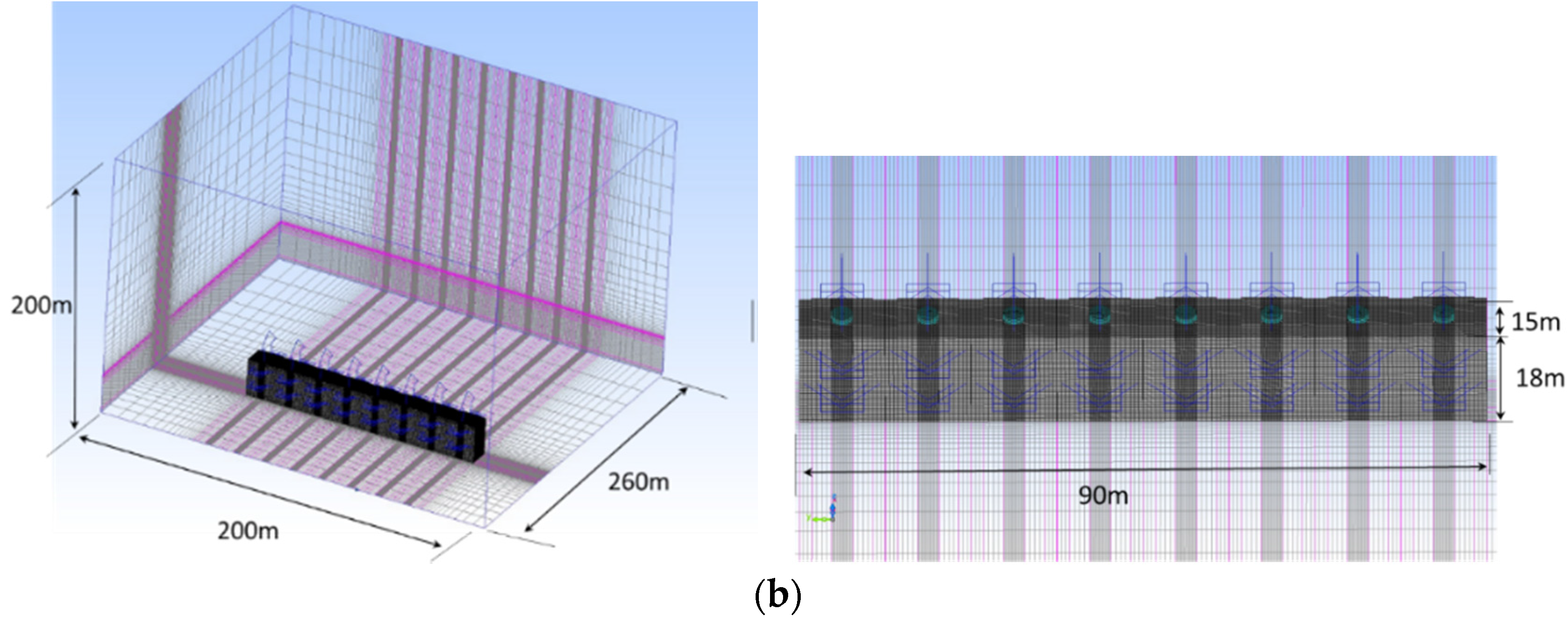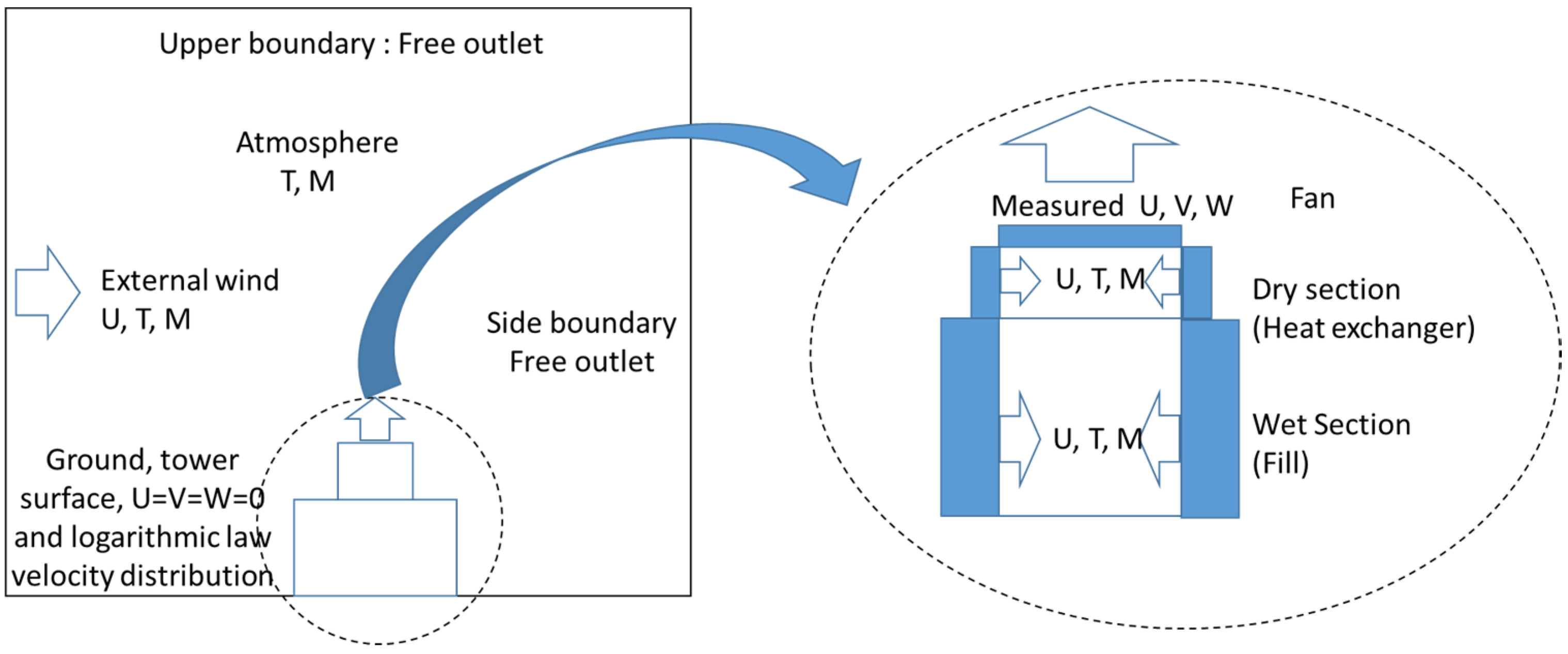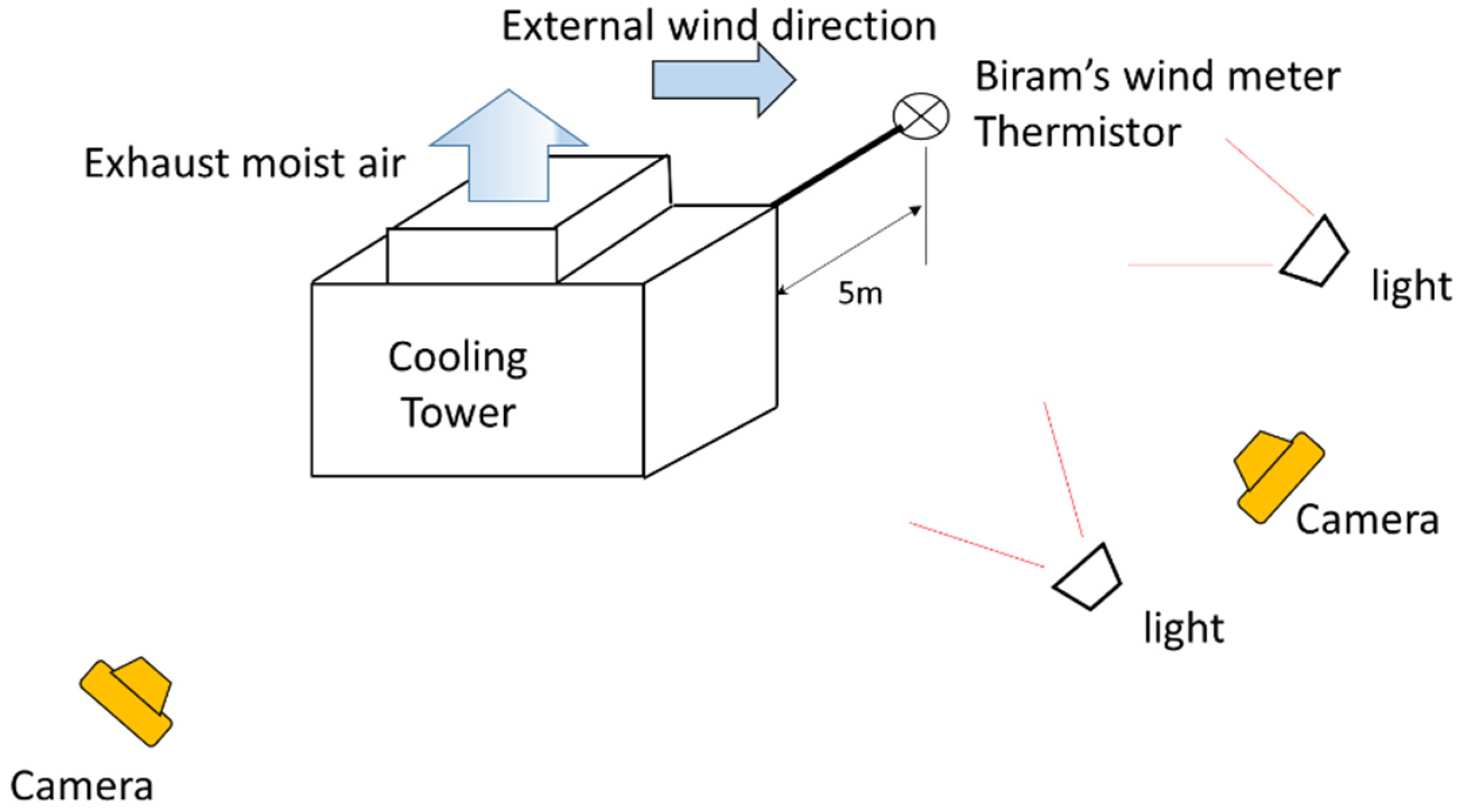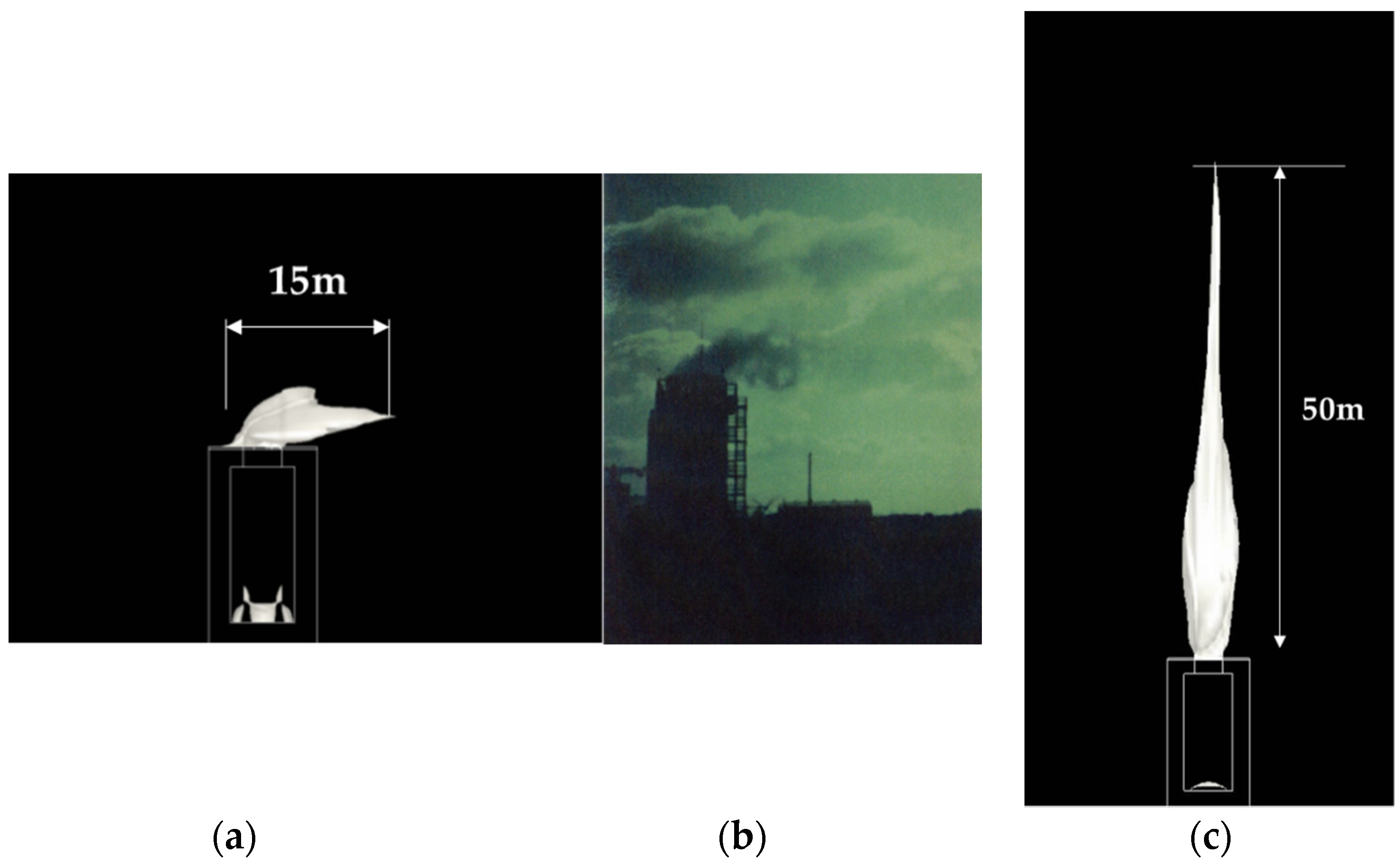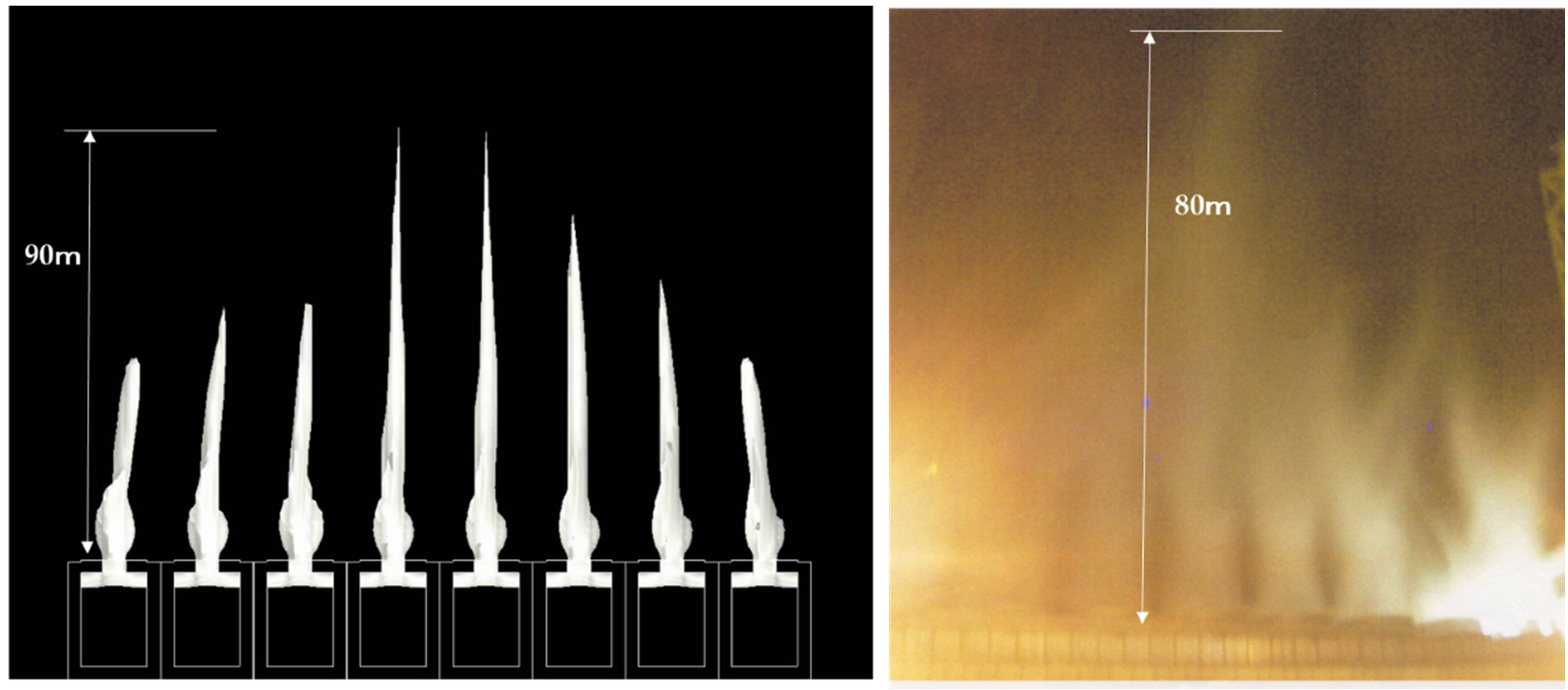1. Introduction
Heated moist air rising from a cooling tower forms a visible plume in winter, the rainy season, and/or a time of day having high relative humidity, such as early morning. The plume itself is simply an oversaturated air-water mixture, and thus not a pollutant; however, it sometimes causes environmental issues such as creating lower visibility, obstructing sunshine, increasing humidity in the surroundings, being mistaken for fire, visually impacting the landscape, and icing [
1]. Therefore, the environmental impact assessment and plume abatement of a cooling tower have been necessary for district heating and cooling systems in cities and airports, in power generation plants near cities, and in nature parks.
The prediction of a visible plume has been investigated since the 1970s, mainly in the case of natural draft cooling towers. For example, a plume has been numerically obtained using a one-dimensional integral model for momentum, energy and pollutant mass transport equations, where the wind velocity, temperature and moisture were found experimentally with Gaussian distribution in the plane perpendicular to the flue [
2,
3]. The results agree well with the actual visible plume rising from a cooling tower of a power plant. An experimental study found that the effect of wind and obstacles on a visible plume can be clarified using a wind tunnel to establish the diffusion model for predicting the scale [
4]. Additionally, a study on mutual interference and the impact on the surrounding environment of a large-scale visible plume was conducted by making aerial observations [
5].
The phenomena of research described above were of such large scale that it is expensive and very time-consuming to predict the occurrence of a visible plume under various conditions, and a cost-reducing procedure is therefore required for the design of a cooling tower and the consideration of the effect of a tower on the environment.
From the late 1980s to 1990s, with the development of computers and analysis code of fluid flow, computational fluid dynamics (CFD) analysis has been applied as an alternative method of physical experiments to obtain complicated flow behavior and transport phenomena. However, CFD analysis uses momentum and energy transport equations to obtain the velocity and temperature distributions [
6,
7]. To visualize the plume from a cooling tower, a moisture transport equation has to be used together with the equations mentioned below.
For such a situation, Takata
et al. [
8] predicted the visible plume from a cooling tower for design purposes. Their results show that the predicted visible plume rising from a mechanical-draft cooling tower agrees well with observed plumes within a practically permissible error range. The effectiveness of predicting main features such as the length, width, and volume of the visible plume were demonstrated. A Reynolds-averaged Navier–Stokes (RANS) model with the standard k
–ε model has been used in simulation, but the effects of the wind fluctuation and exhaust plume have not been well expressed in the RANS model. It may be possible to well express the effects if direct numerical simulation is applied. However, this would require huge computer capacity and computation time to predict the phenomena. At this time, direct numerical simulation cannot be applied for the purpose of design.
The present study applies the RANS model to predict a visible plume rising from a dry and wet combined-type cooling tower with a mechanical-draft device (fan) that abates the plume. Additionally, by predicting the flow behavior within the cooling tower where moist air and dry air are mixed, and dominant phenomenon of reducing the visible plume is considered together with the effect of external wind on the visible plume.
2. Outline of a Cooling Tower
There are many adoptions of cross flow cooling towers with a mechanical-draft device in various industrial fields, and a schematic diagram is shown in
Figure 1a. The cooling tower mainly consists of frame structures including a water tank, rotating fan as a mechanical-draft device, water spray system, and fill for heat exchange. A rotating fan is set on top of the cooling tower and introduces outside air to the inside of the cooling tower. Hot water is sprayed on the top of the fill and then comes into direct contact with the introduced air while flowing down inside the fill, and cooled water flows down into the cooling water tank. The introduced air is heated and humidified, and is exhausted by a fan to the atmosphere as moist air. The exhausted moist air is cooled through contact with the atmosphere, the temperature of which is below the exhaust-air temperature. The water vapor contained in the exhaust air then condensates and forms a visible plume.
For the abatement of the visible plume, a dry and wet cooling tower is used, as shown in
Figure 1b. A dry section is added above the wet section, and a fin-tube heat exchanger is usually used. First, hot water is supplied to the heat exchanger to heat the introduced air and to reduce the relative humidity in the dry section. Hot water is then sprayed on the fill (wet section) and flows downward while being cooled. The airs from dry and wet sections are mixed and exhausted from a fan. The air from the wet section is humidified to almost its dew point; however, the relative humidity of exhaust air is reduced by mixing the exhaust air with air from the dry section. The extent of the visible plume is therefore reduced outside the cooling tower.
The present study predicts the visible plume of both wet and dry and wet cooling towers and examines the validity of the calculation by comparing the prediction with observed plumes. Additionally, the behavior and abatement mechanism of the plume are investigated.
3. Numerical Calculation
Figure 2 shows the operating lines of both wet and dry/wet combined operation lines on an air chart, which connect the exhaust air from the cooling tower to outside air conditions. In wet operation, the condition of air exhausted from the cooling tower is thought to change along the operating line (wet), and humidified exhaust air conditions finally become similar to the outside air condition at a distant point through turbulent diffusion in the atmosphere. At the same time, the air condition under dry and wet combined operation is shown in
Figure 2. The introduced outside air is heated by the heat exchanger with constant absolute humidity. The heated outside air from the dry section and moist air from the wet section are mixed and exhausted. The operating line connects the mixed exhaust and outside air conditions as shown in
Figure 2. It is obvious that the crossing points of the two operation lines and the saturated line are different, and the oversaturated area of dry/wet combined operation becomes small compared with that of wet operation. The change in air condition on the operating lines can be obtained through CFD analysis considering momentum, energy, and moisture (absolute humidity) transport equations, and this procedure allows the prediction of the visible plume.
3.1. Governing Equations and Calculation Procedure
The air velocity of the cooling tower at the exhaust fan is considered to be 20 m/s at maximum, and compressibility is thus considered to be low. Therefore, governing equations for an incompressible fluid used in this study are the continuity equation, Navier Stokes equation with Bousinessq approximation employing a renormalization-group k
–ε model, and transport equations of energy (k), turbulent dispersion rate (ε) temperature (T), and absolute humidity (M) as follows:
where
μ,
ρ,
g and
β mean fluid viscosity, density, gravity force and volumetric thermal expansion coefficient, respectively Also C
p, K, and D mean specific heat, thermal conductivity and diffusion coefficient of air, respectively. In the model, the Reynolds stress term appearing in Equation (2) is assumed as follows:
where
μt means eddy viscosity of fluid and defined as follows:
The fluctuation correlation term appeared in Equations (5) and (6) are assumed as follows:
where K
t means turbulent thermal conductivity, and D
t means turbulent diffusion coefficient. In this calculation, the turbulent Prandtl number
Prt = 0.9, and turbulent Schmidt number
Sct = 0.9 were used. The abbreviations appeared in Equations (3) and (4) are shown as follows:
Also, the following numerical values are used in the parameters appearing in the above equations.
where
An orthogonal grid was used in this simulation, and the equations were solved using the analysis code “stream”. The calculation was conducted under the time-dependent condition, and continued until the time when the velocity, temperature and moisture were no longer varied. The oversaturated area in the computational domain was visualized as a visible plume.
3.2. Cooling Tower Model, Initial and Boundary Conditions
3.2.1. Calculation Model
Cooling tower models and computational domains were designed as follows. The actual shape of a cooling tower is an inverted trapezoid as shown in
Figure 1. As an orthogonal grid is applied in this study, a huge number of grid points is required to express the actual shape of a cooling tower. To reduce the number of grid points and to shorten the computational time, the shape of the cooling tower is adjusted to a rectangular module that has dimensions almost the same as those of the actual cooling tower. The effect of this small adjustment on the computation is considered to be small.
Figure 3 shows two cases of the calculation model.
Figure 3a corresponds to Runs 1, 2, 5, 6, 7, 8 of
Table 1 described later, and
Figure 3b corresponds to Runs 3 and 4 composed of eight cooling towers. In this calculation, a finer grid was applied in the fan area, and a rectangular fill shape was applied to reduce the number of mesh cells.
3.2.2. Wet Operation
Figure 4 shows the initial and boundary conditions used in this calculation. In wet operation, measured velocity distributions, temperature and moisture were given as the boundary conditions. The velocity distribution at the exit of the fan was measured using model equipment with a fan diameter of 580 mm by Takata
et al. [
8].
Figure 5 shows the measured velocity distributions obtained by a laser doppler velocimeter at the outlet of the exhaust fan. The velocities in three directions are normalized by the peripheral tip velocity of the rotating fan, and the positions of measured velocities are normalized by the radius of the fan. The measured velocity profile was assumed to be similar to that of the actual tower. The use of measured velocities as a boundary condition is considered to be effective in accurately predicting the effect of radial and circumferential direction flows produced by the rotating fan. However, although it would be ideal to solve the velocity distributions generated by the rotating fan, it is difficult to obtain the detailed velocity distribution through CFD analysis applying a moving boundary problem to the fan. Therefore, for simplification of the calculation, the measured velocity distribution was used. Additionally, measured outside air temperatures (dry bulb temperature and wet bulb temperature, hereafter DBT and WBT), moisture surrounding the cooling tower and wind velocity shown in
Figure 5 and
Table 1 were given as the initial and boundary conditions in the computational domain.
3.2.3. Dry-and-Wet Combined Operation
In dry and wet combined operation, air conditions and the flow rates at the outlets of dry and wet sections were given as boundary conditions. Here, the outlets of the dry and wet sections are located inside the cooling tower as schematically shown in
Figure 4. Because the air passes through the dry and wet sections, it might be ideal to determine the outlet conditions of dry and wet sections through CFD analysis considering the material and heat exchanges under the direct contact of air and water in the fill. However, the transport phenomenon in the fill is so complex that it is difficult to simulate. In this CFD analysis, the air flow rate and temperature at the exits of dry and wet sections were determined according to the actual design calculation, based on the experiments of cooling performance. The same velocity distributions used in the wet operation were also given in the exhaust fan area. In this calculation, the velocities of the fan area and dry and wet sections were given in the computational domain, so that air volume from the exhaust fan and that from wet and dry sections were set equal to maintain mass conservation. By adopting such a procedure, we clarify the effect of velocity components in three directions produced by the fan on the mixing of dry air and wet air following the collision immediately under the fan.
3.3. Calculation Conditions
Calculation conditions are given in
Table 1. In this calculation, the plume length was validated under several conditions.
